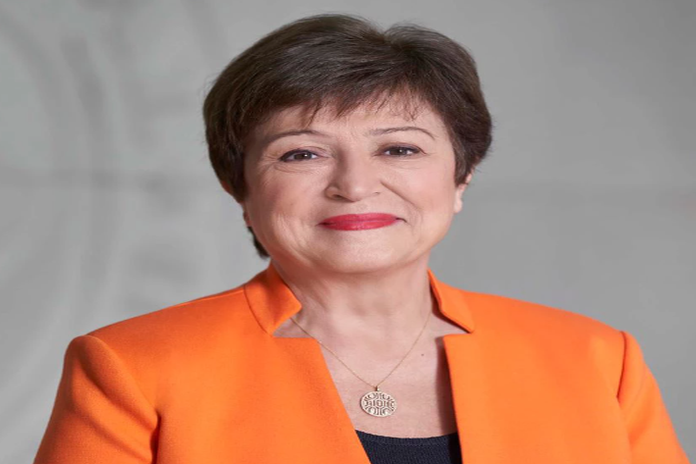During your years at the helm you [President of the European Central Bank, Madame Christine Lagarde] led the Fund through turbulent times – the aftermath of the Global Financial Crisis, and the Euro area sovereign debt crisis. And you steered the Fund to adapt to a changing world – by broadening the institution’s perspective on the macro-criticality of inequality, governance, gender, and climate; and by making sure the quotas reform is advanced, so the Fund can better represent its membership. During COVID the social spending floors introduced in 2018 made a material difference in Fund support to the membership.
I am immensely grateful for the fortune to come after you and advance your legacy. I am also a direct beneficiary of your relentless pursuit of breaking new ground for women – first woman-chair at Baker McKenzie, first woman-minister of economy and finance in France, first woman-managing director of the fund, first woman-president of the ECB. I can vouch from experience that when you break the glass ceiling it is so much easier for the next woman to come!
Of course, another indelible mark you left at the fund is the creation of the Michel Camdessus Lecture series!
So, on behalf of all of us here today [September 20]: thank you for your friendship, leadership, and exceptional contributions to our entire membership. And thank you for gifting us the Camdessus Lecture series and coming to give one today.
Cautious optimism about a soft landing
Before I turn the floor to you, let me briefly reflect on developments in the world since last year’s Camdessus Lecture.
This has been a year of determined action of central banks – of synchronized tightening of monetary policy to address the surge of global inflation. Not popular, but necessary.
Despite of it, inflation remained stubbornly high and it generated in some places concern about the effectiveness of monetary policy.
Fast forward to today, and we are clearly in a better place.
Inflation has declined significantly, to or near target in many economies. It is the result of resolute actions of central banks, as well as fading supply shocks. The forces of monetary policy transmission have re-asserted themselves in the end.
We are in a better place, but we can’t be complacent. First, in many countries, services inflation is persistent, and inflation could yet tip upwards.
Second, in more shock-prone environment, we simply don’t know what surprise may hide around the corner. Since COVID and Russia’s invasion of Ukraine, it has become clear central banks need to scan the horizon beyond monetary and financial sector developments.
Above all, as we know central bankers face a balancing act. They must ensure that inflation sustainably returns to target – and remain there – while avoiding the risk of excessively tight policies. This is particularly important in a world faced with a low growth/high debt conundrum.
Yet, we can be reasonably confident we have entered the “last mile” in the fight against inflation, allowing most central banks to enter an easing cycle – with ECB in June and the Fed this week marking the most important developments.
Over the last year at the fund we have been on the side of the “softlanders” – a win against inflation without a sharp global downturn. In fact, while clearly weaker than we would want, economic activity has been remarkably resilient: we are projecting global growth to be more than 3 percent this and next year.
Structural shifts and monetary policy
So what next? The fight against inflation has come against the backdrop of four and a half years of extraordinary challenges for central banks. And while inflation is retreating, rates are going down and recession appears unlikely, challenges will abound. We are living in a more shock-prone world, a world in which geopolitical considerations turn into geo-economic fragmentation, and a world of tremendous structural shifts due to the green and digital transformation.
In this new world, central banks must be vigilant to the potential for shocks to unleash powerful inflationary forces and create difficult tradeoffs. And they must grapple with ongoing structural changes in the financial sector and the broader economy. We must urgently invest in understanding how the growing importance of non-bank financial institutions could affect the transmission of monetary policy and create new tradeoffs between price and financial stability.
As you do in ECB (and we do at the fund), we need to recognize the rapid increase of climate-related financial stability risks and the tremendous growth and jobs potential of greening the economy.
We must manage the gains and the disruptions of AI, which could provide a major impetus to productivity growth but also increase inequality if not accompanied by supportive policies. And we need to monitor how further advances in digitalization transform the financial landscape. Digital assets, including central bank digital currencies, stand out as potential game changers.
Last but not least, the conduct of fiscal policy is and will remain relevant to the job of central bankers – complicated by the higher levels of public debt.
Christine, in such a rapidly changing environment, your lecture on structural shifts and monetary policy could not be more timely. With your exceptional career, you are uniquely positioned to consider the future of monetary policy strategies and toolkits, both conventional and unconventional.
You have often said that your experience as an elite athlete in the French synchronized swim team helped define your managerial style. You have embraced collaborative leadership. You value discipline, endurance and strategic planning. And you always act with grace under pressure. These are all essential qualities for a central banker – especially one blessed to do the job in such interesting times!
Setbacks and strides forward: Structural shifts and monetary policy in the twenties





